
From Twitter to X
Opinion by Azfar Hasin
The social media platform X, formerly known as Twitter, has had a rocky year since billionaire and entrepreneur Elon Musk decided to take it over after a messy purchase finalized in October 2022 for $44 billion. Musk has taken several actions since the acquisition in his efforts to prevent spam bots and remove what he termed as unconstitutional censorship; he has also instituted new subscription options as well as massive layoffs in his efforts to make the platform profitable.
Musk’s stated reason for the purchase was to, in his own words, “reinstate free speech.” He has called himself a free speech absolutist and has unbanned several accounts related to controversial actions or beliefs. One such account that has been unbanned is former President Donald Trump’s, which was suspended in the days following the January 6th attack on the Capitol building in Washington, D.C. He has also reinstated other accounts that were banned for violations of the terms of service relating to hate speech and disinformation. Mr. Musk’s decision to reinstate these accounts have drawn the ire and scrutiny of critics, who have claimed that his actions have supported the far right. In fact, a recent study conducted by the Center for Countering Digital Hate noticed a significant uptick in the rate of hateful comments on the platform since the takeover. This has in turn caused many advertisers to pull their ads from the site, greatly affecting its financial well-being.
The platform previously known as Twitter has also affected Musk’s other companies, such as Tesla, which underwent a steep decline in stock price in the months following the purchase of Twitter. Tesla, an established brand in the electric vehicle industry, faced a sharp decline in its stock due to market concern following the Twitter takeover. The decline was also exacerbated by other considerations, such as the global chip shortage that developed during the early stages of the COVID pandemic. Mr. Musk has reportedly lost 80-90% of Twitter/X’s worth since its purchase, meaning that X is now only worth $4 billion.
To be fair, Twitter has never been a profitable company; instead, its value came from its essential role in the world of news and content generation. In an effort to stop declining profits that have plagued the company since its inception, Elon Musk has pushed Twitter Blue, a subscription service where paid members get access to more features, such as the ability to edit posts and preferential placement, as well as the highly prestigious blue checkmark. Previously, accounts had to go through a formal vetting process to receive such verification. Critics of the platform have derided these changes as opening up the possibilities of impersonation and bot activity while decreasing the prestige of the blue checkmark.
As X’s ad revenue continues to decline, Mr. Musk has threatened to sue the Anti-Defamation League, an organization advocating against antisemitism and hate speech that has been critical of the changes on the platform. Many folks criticized this turn as antisemitic and pointed to the delighted reaction of many confirmed antisemites and neo-Nazis on and off the platform.
Fortunately, those using X and other social media platforms are able to moderate their experiences through a few tools available to them. These tools include making your account private, which limits those who can interact with your posts; blocking or muting unwanted users; and reporting content such as hate speech. In addition, X still includes the Community Notes feature, in which vetted users add clarifying context on posts with disinformation (deliberate falsehoods) and misinformation (incorrect facts). In this way, users can tailor their social media interactions to limit contact with distressing content.
Elon Musk’s leadership over Twitter/X have raised important concerns over the importance of moderation and how far freedom of speech should reach, as well as renewed debate over how social media companies should deal with increasing hate speech. Whether or not Elon Musk’s approach to running a social media platform will be successful, we will have to wait and see.
Read More
Artificial Intelligence
by Anaelle Tadros
Artificial intelligence isn’t a new concept; in fact, in 1956, John McCarthy coined the term at Dartmouth College. However, the topic of AI has become more common and has been popping up in a lot of conversations recently. There have been lots of questions about whether or not AI is beneficial for our society, or if it’s going to ruin and deteriorate the community. It has been especially controversial in terms of its uses in education. Lots of AIs are ones we are familiar with, like Apple’s Siri,  Amazon’s Alexa, and Microsoft’s Cortana. Some other systems use AI too, like Tesla and the latest models from BMW. The car companies use AI algorithms for their self-driving models. Other situations where AI is used are in content creation in marketing, advertising, and movies.
Amazon’s Alexa, and Microsoft’s Cortana. Some other systems use AI too, like Tesla and the latest models from BMW. The car companies use AI algorithms for their self-driving models. Other situations where AI is used are in content creation in marketing, advertising, and movies.
Recently, it’s also been used to help with natural disasters. California’s main firefighting agency is using AI to find visual signs of wildfires. They’re using over a thousand high definition cameras to locate where fires are happening and determine how fast they are spreading. When signs are apparent, the AI models send alerts to the state’s fire department control center to prevent the fires from spreading. The only issue is that human confirmation is required to make sure that these alerts are true and not just false alarms. According to ArsTechnica.com, this has been a problem, with the alerts being frequently set off by fog or by steam from geothermal plants. Setting up these systems also takes a lot of time and effort, and could therefore take away resources and focus from other important emergency initiatives.
AI has a bit of a negative connotation, with many people worried it may soon be able to take over the world. However, our school has used it for a lot of great projects, such as informational posters in the hallways, and many are hoping to incorporate it into our learning environment even more. Because AI is guaranteed to be a part of our generation’s future, our school held a meeting on November 13th to discuss ways our school district could better incorporate AI in the classroom. During this meeting, several people discussed how they use various AI software, while others explained how they use AI in appropriate ways for their own artwork and in drafting college essays. One person used AI for help in compiling their resume and another proposed the idea of using AI to make team shirt designs.
 In this meeting, problems from AI were also discussed, with some mentioning that the suitability of AI’s usage really depends on the person using it. AI can be thought of as a harmful resource because lots of individuals use it to cheat and plagiarize. However, if given to the right person, they will use it as a way to improve their work and learn more deeply. For example, one person may use AI to write an essay, giving them either no benefit in learning how to write effectively themselves or giving them an unfair advantage in the system, while another person may use AI responisibly to give their essay more polish, maybe using it to find stronger phrasing or correct grammar mistakes. A student mentioned using AI to ask questions about a topic they were unclear on from their science class, thus showing how AI allowed them to deepen their understanding. Speaking of cheating, AI is also useful in finding instances of plagiarism. Applications like Turn It In and Grammarly have AI softwares that are used to make sure students aren’t just copying and pasting another person’s work.
In this meeting, problems from AI were also discussed, with some mentioning that the suitability of AI’s usage really depends on the person using it. AI can be thought of as a harmful resource because lots of individuals use it to cheat and plagiarize. However, if given to the right person, they will use it as a way to improve their work and learn more deeply. For example, one person may use AI to write an essay, giving them either no benefit in learning how to write effectively themselves or giving them an unfair advantage in the system, while another person may use AI responisibly to give their essay more polish, maybe using it to find stronger phrasing or correct grammar mistakes. A student mentioned using AI to ask questions about a topic they were unclear on from their science class, thus showing how AI allowed them to deepen their understanding. Speaking of cheating, AI is also useful in finding instances of plagiarism. Applications like Turn It In and Grammarly have AI softwares that are used to make sure students aren’t just copying and pasting another person’s work.
Recently, Principal Mr. Lauchu, Asst. Principal Mr. Rosenthal, Computer Science teacher Mr. Bradfield, and SciFi parent and STEM adviser Mr. Tsao sat down together to discuss the implications of artificial intelligence in the classroom, and LAUSD has released their discussion as a podcast.
Listen here: https://www.lausd.org/Page/16535

To prove the point that AI is quickly being incorporated into so many settings, I used ChatGPT for the first time in my life to write this concluding paragraph:
In conclusion, the advent of artificial intelligence has ushered in a transformative era, reshaping the landscape of industries, society, and human interaction. As AI continues to evolve, its potential for innovation and efficiency is undeniable, offering solutions to complex problems and unlocking new possibilities. However, the ethical implications and potential risks associated with AI demand careful consideration and responsible development. Striking a balance between harnessing the benefits of AI and safeguarding against its potential pitfalls is crucial for a sustainable and inclusive future.
If you have ideas about how AI can help improve our learning, don’t be afraid to share them with our teachers and administators!
Sources:
- What is Artificial Intelligence in 2024? Types, Trends, and Future of it?
- What is Artificial Intelligence (AI) ? | IBM

NASA TechRise Challenge
by Ryan Kim
Have you ever wanted to conduct an experiment in a space-like atmosphere or design an experiment for NASA? In the new 2024 TechRise Student Challenge, you can do exactly that. Interested students can join any time before October 20. Those in the Robotics or StellarXplorers clubs may be especially interested.
NASA has invited all schools with students in grades 6-12 to form a group to design, build, and submit an experiment to be held in a high-altitude balloon or rocket-powered lander in the 2024 TechRise Student Challenge. Students can participate in the challenge by going to https://www.futureengineers.org/nasatechrise, and submitting their proposals.
How To Participate
To participate in the challenge, students must first form a team of four students and a team leader (a teacher or school employee). The team can consist of four students spanning from grades 6-12 with no limit of students per team. Secondly, students must read the proposal template and guide at https://tinyurl.com/mru394z2. Next, choose between a rocket-powered lander or a high-altitude balloon for your experiment. The rocket-powered lander includes a clear view out to the ground from eighty feet, or about as high as a six-story building. The flight time for your experiment will be about two minutes. From the balloon, your experiment will be open to the air with the ability to take pictures vertically and horizontally. It will ascend through the troposphere and into the stratosphere from Baltic, South Dakota while attached to a frame called a gondola. Once it reaches 70,000 feet, the balloon will stay there for at least four hours. After the experiments have been concluded, the balloon will separate from the gondola and fall to the ground where NASA will retrieve the experiments.
 Example of the gondola.
Example of the gondola.
Your team leader can submit the proposal on or before October 20, 2023, and the winners will be announced on January 16, 2024, with a prize package of $1,500 for their experiment, a flight box, technical support for the experiment, and an assigned spot for the experiment. The experiments must be mailed no later than May 10, 2024. The experiments will be launched in the summer of 2024.
 A NASA experiment being launched.
A NASA experiment being launched.
NASA said that the goal of the challenge is to inspire “a deeper understanding of space exploration, Earth observation, coding, electronics, and the value of test data.” All students are encouraged to apply and participate in the challenge, so be sure to send your experiment ideas to TechRise! For more information go to: https://www.futureengineers.org/nasatechrise and https://www.youtube.com/watch?v=aNSdAIDS9lI.
Read More
Aviation Club
by Ryan Park
The Aviation Club is a new club formed this year that helps to educate members around aspects of the field of aviation and to teach its members the mechanics and engineering behind aviation. It was founded by Aviation Club president, Solomon Sharp, who answered a few questions recently in order to encourage students to join. The club meets every Wednesday after school in Mr. Bradfield’s room, located in W30.
When simulating a version of flight, the Aviation Club uses multiple tools in order to have members experience the closest thing to real flight. They have multiple tools that have been programmed to act like the real tools you would find in an aircraft such as the yoke, also known as the control stick. The yoke is used in order to control the movement of the aircraft inside the simulators.
What is the purpose of your club?
The Aviation Club is based on educating our members about all aspects of aviation as a whole and teaching them how to use flight simulation technology. As the world is in high demand for pilots and engineers, having knowledge and experience in the field is an important foundation when choosing a career related to aviation. Being involved with aircraft requires many different skills, many of which are applicable to everyday life, and none are exclusive to a specific field. When I started my training as a pilot several years ago, I realized how much I wanted to share this world with other people wanting to take that first step, and how beneficial it could be to their lives.
What is some background info about your club?
A technical and mechanical understanding of aircraft, such as understanding the science of how a vehicle flies and what comes with it, is important not only for engineers but for pilots as well. Flying requires a fundamental understanding of the machine you are commanding and by having that understanding, you can be that much more effective. Aerodynamics, engine mechanics, electronics, and more all go beyond aviation and can be applied in many different fields. One of the most important skills in the world of aviation, though, is of teamwork. Every pilot, engineer, and mechanic all work in conjunction with one another, and none can work with a missing link.
What are some major projects you plan on releasing?
This year, one of our goals is to get everyone hands-on experience with real aircraft, both for maintaining them and flying them. We have already formed strong connections with professional aviators, and the date is currently being coordinated for these goals to be achieved. We are also shooting for designing a remote control model for a plane/drone and constructing it to demonstrate the effectiveness of our design.
What would you say to people interested in your club?
To anyone who is interested in the club, feel free to come and check it out! If you want to see what we’re up to, come to Mr. Bradfield’s room on Wednesdays after school and you might catch us on the simulators. We would love to have new members, and if anyone is interested in joining, come and let me know!


 Club pictures
Club pictures

A Guide To The Coronavirus: Origins, Genetics, Vaccine Testing and More
by Suren Grigorian
Following the recent outbreak of the novel coronavirus resulting in an increasing number of infected people, we are entering a new era filled with fearful projections of the future. A large majority of that fear appears to originate from fear of the unknown, specifically from the fact that among the individuals representing the statistical majority of the public, a small quantity possess actual knowledge of the scientific mechanisms responsible for the dissemination of the virus or what may remain attempted to halt the aforementioned spread. The fact that the mechanisms of the virus, to the general public, remain an opaque novelty is particularly dangerous, as ignorance fosters misinformation and misconceptions; thus, this article shall attempt to elucidate the fundamental principles behind the outbreak in a manner which, the author hopes, shall relieve a small quantity of the anxiety associated with this event, an event which has effected great change upon the lives of us and our relatives.
For an individual to understand the fundamentals of the outbreak, it first remains necessary to understand the virus itself. The virus, currently designated as the Severe Acute Respiratory Disease Coronavirus 2 or SARS-CoV-2 via scientists, primarily remains classified as a member of the family Coronaviridae; generally named for their appearance, similar to a crown beneath an electron microscope. Coronaviruses remain associated with numerous mild illnesses affecting the upper respiratory tract, including the common cold, a small fraction of which remains attributed to them. However, 3 viruses within this family, with the inclusion of SARS-CoV-2, remain attributed to severe respiratory diseases. The origins of the current virus remain slightly obscure, though the development of the virus allows for the delineation of its development. According to current scientific research, the genetic composition of the virus resembles the genetic composition of coronaviruses prevalent among bat species; however, additional evidence links the proteins upon the surface of the virus (discussed in additional detail further onwards) to pangolins, with the former remaining a particularly plausible explanation. Though the origins of the virus do not remain certain, a recent scientific statement within The Lancet regarding the danger of virus conspiracy theories cites papers analysing its genetic composition. One such paper concludes that the coronavirus possesses an approximate 88% similarity to 2 bat coronaviruses, providing general evidence that the virus remains of natural origin.
With a generalised scientific outline of the taxonomy and epidemiological history of the virus established, one can proceed to the biological components of the virus within its generality. To establish the fundamental biology of the virus, one must begin with its typology. The novel coronavirus remains classified as a positive-sense single-stranded RNA virus; the virus itself possesses an approximate width of 90 nanometres, while 4 varying proteins remain contained within the virus, in addition to the previously referenced genetic material. The virion primarily remains distinguished as a mammalian virus due to its external phospholipid membrane; such a membrane, primarily constructed from the external plasma membrane of the cells which the virus infects, assists within entry. The genetic material of the virus primarily contains approximately 29,900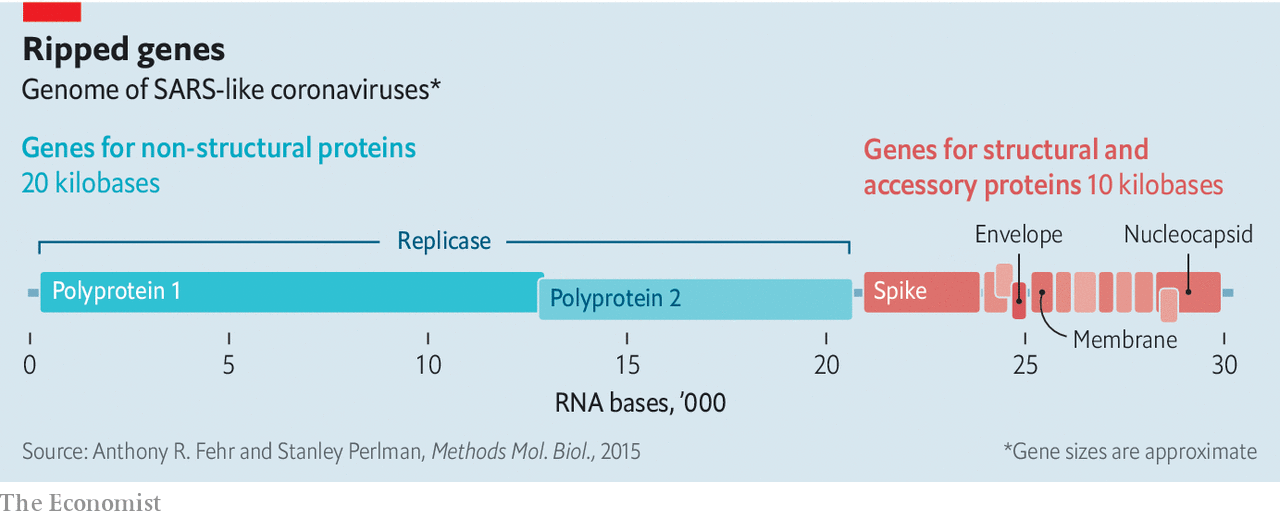 nucleotides, a miniscule quantity in comparison to the gene sizes known to us today, but massive for the large majority of RNA viruses. The internal components of the genetic material of the virus determine the process of infection. 20,000 RNA bases, 20 kilobases within the virus, remain devoted to replicase genes, responsible for the construction of polyproteins, which remain divided into non-structural proteins. An additional 10 kilobases remain devoted to essential and accessory proteins, including the spike, envelope, nucleocapsid and membrane proteins. However, the large majority of scientific discussion concerns the membrane of the virus; here, the key to entry within a cell remains located.
nucleotides, a miniscule quantity in comparison to the gene sizes known to us today, but massive for the large majority of RNA viruses. The internal components of the genetic material of the virus determine the process of infection. 20,000 RNA bases, 20 kilobases within the virus, remain devoted to replicase genes, responsible for the construction of polyproteins, which remain divided into non-structural proteins. An additional 10 kilobases remain devoted to essential and accessory proteins, including the spike, envelope, nucleocapsid and membrane proteins. However, the large majority of scientific discussion concerns the membrane of the virus; here, the key to entry within a cell remains located.
ACE2, scientifically known as Angiotensin I Converting Enzyme 2, remains established as a protein receptor upon the surface of human cells responsible for regulation of cardiovascular and renal metabolism. However, it serves as a binding protein receptor to the spike proteins of SARS-CoV-2, forming a primary and crucial component of the entry of the virus into a healthy cell. An additional factor responsible for assisting the entry of the virus into the archetypal cell remains the serine protease TMPRSS2, responsible for assisting within S protein priming. The function of this remains the splicing of the aforementioned spike protein, producing a fusion peptide and allowing finalisation of entry. The surface of the virus additionally possesses such receptors as hemagglutinin esterase; however, this does not remain particularly applicable to the mechanisms via which the virus remains responsible for infecting human cells.
However, an essential component of the general effect of the virus upon the human body remains the entry of a singular virus within a singular human cell. This occurs via a detailed biological process responsible for general infection. Firstly, the spike protein receptors upon the surface of the virus attach to the ACE2 receptors upon the surface of the human cell (As previously referenced, the serine protease TMPRSS2 splices the spike protein, producing a fusion peptide and allowing entry). Following this, a series of processes occur which allow for the replication of the simplified genetic material of the cell via the utilisation of replicase enzymes which exist within the cell itself; a set of pp1a and pp1b polyproteins remain produced, primarily responsible for the formation of a replicase-transcriptase complex, which manufactures replicated RNA segments. As viral proteins remain manufactured and assemble concomitantly to the proteins comprising the viral body, exocytosis occurs, releasing additional viruses into the interstitial fluid of the body and producing the incipient entrance instances of a viral infection within the body. The spike proteins which mediate these processes within viruses (including the virus responsible for the SARS outbreak within the early 2000s) and those within the coronavirus remain generally similar.
Though individual mechanisms of infection remain a component of the damage produced via the virus, its general effects upon the body and its methodology of attack remain an additional component. Analysis of this requires a general understanding of the immune system. A singular component of the mechanism utilised via the coronavirus to conduct a total bodily infection remains the offensive upon the human lungs. Following infection, virions enter the alveoli of the lungs, the primary centre for respiration and the general absorption of oxygen from atmospheric substances. With the virus inflicting severe damage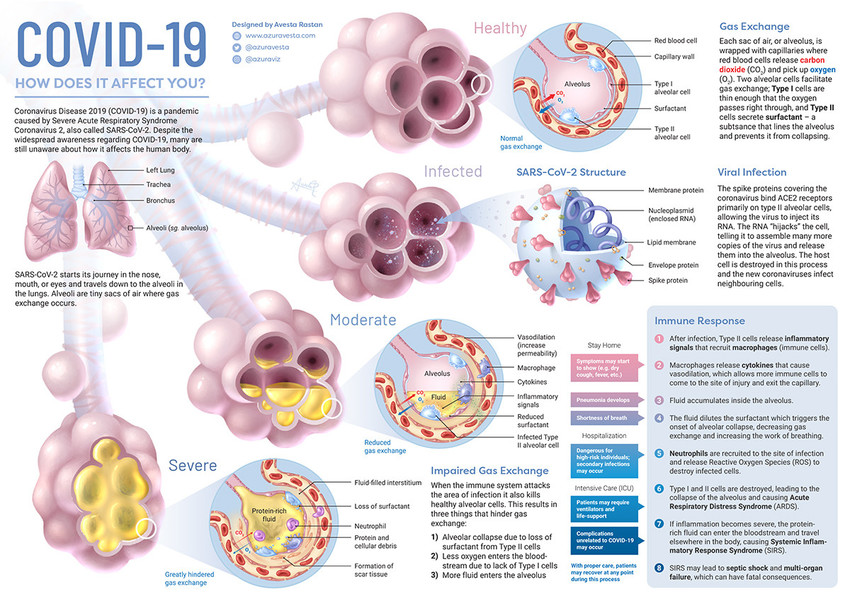 upon the cells of the alveoli, leukocytes within the blood attempt to halt the damage, with the immune system producing an excessive reaction known as a cytokine storm. Within the worst instances, the walls of the alveoli collapse, producing acute respiratory distress syndrome. Acute respiratory distress syndrome remains defined as a respiratory disorder within which fluid from capillaries within the alveoli begins to leak, producing decreased quantities of oxygen within the blood stream and a condition known as hypoxemia. Following this, severe organ damage occurs, with potential sepsis resulting from immune system activity and producing a possibility of death. The final stage within the dissemination of the virus remains its spread to additional individuals. This primarily occurs via a system of release which necessitates the utilisation of masks; according to the Centers for Disease Control and Prevention, the virus primarily remains released via infectious droplets of saliva or mucus, producing infections within additional individuals.
upon the cells of the alveoli, leukocytes within the blood attempt to halt the damage, with the immune system producing an excessive reaction known as a cytokine storm. Within the worst instances, the walls of the alveoli collapse, producing acute respiratory distress syndrome. Acute respiratory distress syndrome remains defined as a respiratory disorder within which fluid from capillaries within the alveoli begins to leak, producing decreased quantities of oxygen within the blood stream and a condition known as hypoxemia. Following this, severe organ damage occurs, with potential sepsis resulting from immune system activity and producing a possibility of death. The final stage within the dissemination of the virus remains its spread to additional individuals. This primarily occurs via a system of release which necessitates the utilisation of masks; according to the Centers for Disease Control and Prevention, the virus primarily remains released via infectious droplets of saliva or mucus, producing infections within additional individuals.
However, to produce a general understanding of the methodologies necessary for the development of an epidemic and an eventual pandemic, one must understand the mathematics of epidemiological dissemination; in particular, the development of the coronavirus remains reliant upon exponential growth. In particular, the general model utilised via epidemiologists remains the SIR model, additionally known as the susceptible, infected and recovered model, with the addition of exposed individuals. Utilisation of this model requires the application of Rₒ, the quantity of individuals which may remain infected as a fraction of the quantity who contact an infected individual. Following the progression of an epidemic, epidemiologists adjust this in association with variations within the progression of the pandemic, though the Rₒ of the virus remains 3. The mathematics of the development of the pandemic ultimately remain dependent upon this; the development of the epidemic, however, progresses beyond simple transmission models.
One could primarily characterise the development of the pandemic within an SIR model via a formula within which the change within the quantity of cases per day, perhaps represented as ΔC, remains equivalent to the quantity of individuals exposed each day, multiplied via the quantity of existing cases, multiplied via the probability of contracting the virus provided an instance of contact. When one utilises such a model, it remains effortless to note that at a particular point within the outbreak, all individuals within the population will remain infected and the virus will remain incapable of disseminating further. The question remains if the outbreak remains capable of infecting all individuals within the population, a definitively avoidable outcome; if this occurs, one could expect to
change within the quantity of cases per day, perhaps represented as ΔC, remains equivalent to the quantity of individuals exposed each day, multiplied via the quantity of existing cases, multiplied via the probability of contracting the virus provided an instance of contact. When one utilises such a model, it remains effortless to note that at a particular point within the outbreak, all individuals within the population will remain infected and the virus will remain incapable of disseminating further. The question remains if the outbreak remains capable of infecting all individuals within the population, a definitively avoidable outcome; if this occurs, one could expect to observe exponential growth within an outbreak, decaying following a period of time. However, epidemics tend to follow, with the occurrence of restrictions, logistic growth, a mathematical methodology of growth whereby a function continues within a stage of exponential
observe exponential growth within an outbreak, decaying following a period of time. However, epidemics tend to follow, with the occurrence of restrictions, logistic growth, a mathematical methodology of growth whereby a function continues within a stage of exponential
growth for a period of time, following which, at the inflection point, the derivative of the function begins to decrease, within a bell curve pattern. Following this, the development of the epidemic remains drastically reduced, culminating within a flatline, where the quantity of additional cases remains particularly small. In fact, if one plots the derivative of the resulting function, known as the sigmoid function, the derivative intersects the Y-axis at precisely 50% of the value at which the sigmoid intersects; this indicates that the inflection point for the sigmoid function and thus, the point at which the dissemination of the disease begins to halt, occurs at the point within which the derivative attains its largest value.
Though this aspect of the outbreak possesses relevance, a particularly primary aspect remains the history of the outbreak; within weeks of its development, the entirety of the developed world screeched to a halt, industrially, commercially and governmentally. How did this occur? Beginning with the outbreak itself, one could analyse the development of the outbreak from its inception; on November 17, 2019, according to Chinese officials and the South China Morning Post, an individual, 55 years of age, became the first recorded case worldwide of the virus. During the previous year, approximately 266 individuals placed within medical surveillance remained registered; however, the extent of the outbreak became clear to Chinese Communist Party officials upon December 31, when government officials within the province of Hubei announced that several dozen individuals remained within treatment for a novel infectious virus, as of yet unknown to the scientific community. Upon January 11, the Chinese government reported the first death from the novel disease, a man of 61 years who purchased materials from the wet market where the virus remains suspected to have begun; the death occurred upon January 9, when the man, admitted to a medical facility for treatment, failed to recover and died of heart failure. Following this, the first confirmed cases were reported within external nations, as within the following days, Thailand, South Korea and Japan reported cases; upon January 21, the first case within the United States was reported, with a man of 30 years developing symptoms following his return from Wuhan.
Upon January 23, Chinese government officials ordered the immediate placement of the city of Wuhan and the province of Hubei within lockdown, prior to the Chinese Lunar New Year. At this point, approximately 570 individuals remained infected, with approximately 17 dead. The remainder of the nation experienced increased lockdown measures, with Lunar New Year celebrations cancelled. Upon February 2, 3 days following the WHO declaration regarding the coronavirus as an emergency of international concern, China reported approximately 14,380 cases. As the nation of China remained placed within severe lockdown, precautions began within additional nations; several governments imposed testing upon all entering flights and their passengers. Several days prior, human-to-human transmission remained conclusively located, massively increasing the urgency of global preparations. Upon February 9, approximately 37,198 cases remained recorded, with noted Chinese whistleblower Dr. Li Wenliang dying of the disease upon February 7.
On February 14, France became the first nation within Europe to report a death resulting from the novel virus, with Italy reporting 3 deaths upon February 23 and local government officials halting the Venice Carnival, an event which, were it to continue upon its charted schedule, could produce hundreds or perhaps thousands of additional infections. From February 24 to March 1, a wave of incipient cases occurred, with nations such as the Netherlands, Greece, Georgia, Denmark and numerous contemporaries reporting initial cases. With cases exiting the quarantined and docked Diamond Princess cruise ship, upon February 27, the United States government began to consider the implementation of the Defense Production Act, which would grant President Trump the ability to control national production facilities within emergency situations. The first death within the United States occurred upon February 29, with President Trump disrupting travel from Europe upon March 11 and declaring a national emergency upon March 13. Gathering within groups of 50 or greater was promptly chastised via the Centers for Disease Control and Prevention and upon March 15, the New York school system, the largest within the United States, closed. Though the European Union, facing increasing infections, restricted non-essential travel into the bloc, 2 days following the announcement, upon March 19, China reported 0 local infections, with 14 resulting from external travel and approximately 80,967 infections total; the first nation to experience an immediate halt to the continuation of the virus, China reported positive results primarily due to their brutal quarantine measures.
Upon March 30, an influx of state isolation directives remained issued within the United States, with approximately 265 million Americans placed within isolation. Earlier, upon March 13, the Los Angeles Unified School District, the second largest within the United States, announced a 2-week closure, extended first to May 1 and, following the initial announcement, to the terminal end of the school year. As the outbreak continued, numerous additional events began to contribute to its dissemination, with cases surging within Russia, deaths increasing within Iran and Italy and the United States assuming the mantle of the nation with the largest recorded quantity of coronavirus cases upon the planet. `Russia now possesses approximately 300,000 cases, an issue compounded via the manipulation of statistics due to bureaucratic machinations. And thus, our story returns to today.
With this immense quantity of suffering and death, as well as economic difficulties for millions of Americans and global citizens, one would naturally wonder: does there remain a cure? Scientists, researchers and pharmaceutical specialists across the world are labouring to locate a cure; so far, 7 promising treatments remain within clinical trials, according to The Economist. A promising option, one which I am sure our readers have observed within televised media, remains remdesivir, a treatment originally developed via Gilead Sciences, a prominent American pharmaceutical corporation. As a nucleoside analogue, a treatment which mirrors the chemical structure of genetic material, the efficacy of remdesivir primarily remains attributed to its ability to prevent genetic replication. In addition to 2 trials within Asia developed via Gilead Sciences, the chemical remains authorised for emergency clinical utilisation within the United States, with supplies allocated to hospitals within multiple states. However, though promising, it does not halt the effects of the virus totally, with several researchers insisting it possesses a minor effect and a previously cited Chinese study within this article additionally supplementing this view.
If not remdesivir, then what? Trials of the clinical cocktail Lopinavir-Ritonavir, commercially known as Kaletra, remain within progress or completed. However, as within the case of a study published within the New England Journal of Medicine, they do not necessarily deliver promising results, with an additional study published within The Lancet indicating that triple antiviral therapy performed superiorly to Kaletra. Perhaps favipiravir, known as Avigan, then; this appears to remain the case, as the Russian government, in association with domestic pharmaceutical groups, indicated that a trial of the treatment remains near completion, displaying greater than 80% efficacy. Tocilizumab, known as Actemra commercially, remains an additional option; approved for utilisation within China and sparingly utilised within Italy, it prevents inflammatory responses such as the referenced cytokine storm within its standard application as an arthritis drug.
As for vaccines, numerous varying methodologies exist for the development of vaccines to combat the virus. These include live vaccines, viral vector vaccines, nucleic acid vaccines, protein-based vaccines and additional types. Within a live vaccine, a weakened or destroyed version of the virus, with spike proteins intact, remains introduced within the body, allowing for immediate recognition via the immune system and the development of immunity. The American biotechnology corporation Codagenix, within collaboration with the Serum Institute of India, currently remains within the process of developing a deactivated live vaccine. Viral vector vaccines, additionally known as recombinant vector vaccines, utilise the process of genetic modification to introduce relevant spike protein genome sections within the genomes of varying viruses, such as adenoviruses, an approach pursued via Johnson & Johnson and CanSino, the latter of which possesses a Phase II vaccine. Nucleic acid vaccines, a novel and untested development within the field, primarily remain reliant upon recent advances within genetic engineering, whereby the coronavirus spike peptide gene, in addition to a quantity of DNA, remains subjected to electroporation, developing membrane pores to increase acceptance and allowing for the production of spike proteins, triggering an immune response. This remains within Phase I trials under the guidance of Beijing Advaccine Biotechnology Inovio Pharmaceuticals as a DNA vaccine and an RNA vaccine under Moderna and CureVac, the latter of which aims to “print” such components. Protein-based vaccines primarily insert large quantities of independent antigens, triggering an individual immune response; this remains pursued via Clover Pharmaceuticals, Novovax, the notable Sanofi Pasteur and the United States military, among others. With such entities as Oxford University, the US government and Chinese state apparatus developing vaccines, there remains a slight quantity of hope. However, solutions remain within the distant intervals of several months onward.
utilise the process of genetic modification to introduce relevant spike protein genome sections within the genomes of varying viruses, such as adenoviruses, an approach pursued via Johnson & Johnson and CanSino, the latter of which possesses a Phase II vaccine. Nucleic acid vaccines, a novel and untested development within the field, primarily remain reliant upon recent advances within genetic engineering, whereby the coronavirus spike peptide gene, in addition to a quantity of DNA, remains subjected to electroporation, developing membrane pores to increase acceptance and allowing for the production of spike proteins, triggering an immune response. This remains within Phase I trials under the guidance of Beijing Advaccine Biotechnology Inovio Pharmaceuticals as a DNA vaccine and an RNA vaccine under Moderna and CureVac, the latter of which aims to “print” such components. Protein-based vaccines primarily insert large quantities of independent antigens, triggering an individual immune response; this remains pursued via Clover Pharmaceuticals, Novovax, the notable Sanofi Pasteur and the United States military, among others. With such entities as Oxford University, the US government and Chinese state apparatus developing vaccines, there remains a slight quantity of hope. However, solutions remain within the distant intervals of several months onward.
In conclusion, the author hopes that this analysis of the individual components of the worldwide coronavirus outbreak shall provide a sufficient quantity of comfort to those who are subjected to the jarring reality we face today. Hopefully, this virus shall be eradicated, but for now, our thoughts and hopes remain both with the relatives of those lost to the outbreak and to the researchers attempting to develop a cure.
References:
- National Institute of Allergy and Infectious Diseases. (n.d.). Coronaviruses. Retrieved April 27, 2020, from https://www.niaid.nih.gov/diseases-conditions/coronaviruses
- Bryner, J. (2020, April 10). 6 new coronaviruses discovered in bats. Retrieved April 27, 2020, from https://www.livescience.com/6-new-coronaviruses-found-bats.html
- Collins, F., & National Institutes of Health. (2020, March 26). Genomic Study Points to Natural Origin of COVID-19. Retrieved April 27, 2020, from https://directorsblog.nih.gov/2020/03/26/genomic-research-points-to-natural-origin-of-covid-19/
- Lu, R., Zhao, X., Li, J., Niu, P., Yang, B., Wu, H., … Tan, W. (2020). Genomic characterisation and epidemiology of 2019 novel coronavirus: implications for virus origins and receptor binding. The Lancet, 395(10224), 565–574. https://doi.org/10.1016/s0140-6736(20)30251-8
- The Economist. (2020, March 16). Understanding SARS-CoV-2 and the drugs that might lessen its power. The Economist. Retrieved from https://www.economist.com
- Fehr, A. R., & Perlman, S. (2015). Coronaviruses: An Overview of Their Replication and Pathogenesis. Coronaviruses, 1–23. https://doi.org/10.1007/978-1-4939-2438-7_1
- Hoffmann, M., Kleine-Weber, H., Schroeder, S., Krüger, N., Herrler, T., Erichsen, S., … Pöhlmann, S. (2020). SARS-CoV-2 Cell Entry Depends on ACE2 and TMPRSS2 and Is Blocked by a Clinically Proven Protease Inhibitor. Cell, 181(2), 271-280.e8. https://doi.org/10.1016/j.cell.2020.02.052
- Klausegger, A., Strobl, B., Regl, G., Kaser, A., Luytjes, W., & Vlasak, R. (1999). Identification of a Coronavirus Hemagglutinin-Esterase with a Substrate Specificity Different from Those of Influenza C Virus and Bovine Coronavirus. Journal of Virology, 73(5), 3737–3743. https://doi.org/10.1128/jvi.73.5.3737-3743.1999
- Song, Z., Xu, Y., Bao, L., Zhang, L., Yu, P., Qu, Y., … Qin, C. (2019). From SARS to MERS, Thrusting Coronaviruses into the Spotlight. Viruses, 11(1), 59. https://doi.org/10.3390/v11010059
- Oh, J., & Klivans, L. (2020, May 5). How The Novel Coronavirus Hijacks Our Defenses. Retrieved May 24, 2020, from https://choice.npr.org/index.html?origin=https://www.npr.org/sections/health-shots/2020/05/05/850361325/video-how-the-novel-coronavirus-hijacks-our-defenses
- American Lung Association. (2020, March 24). Learn About ARDS. Retrieved May 24, 2020, from https://www.lung.org/lung-health-diseases/lung-disease-lookup/ards/learn-about-ards
- Centers for Disease Control and Prevention. (n.d.). Food Safety and Coronavirus Disease 2019 (COVID-19) | CDC. Retrieved May 24, 2020, from https://www.cdc.gov/foodsafety/newsletter/food-safety-and-Coronavirus.html
- Rogers, A. (2020, March 30). The Mathematics of Predicting the Course of the Coronavirus. Wired. Retrieved from https://www.wired.com
- Gallagher, J. (2020, May 18). Coronavirus: What is the R number and how is it calculated? Retrieved May 24, 2020, from https://www.bbc.co.uk/news/health-52473523?utm_source=rss&utm_medium=Sendible&utm_campaign=RSS
- Ma, J. (2020). Estimating epidemic exponential growth rate and basic reproduction number. Infectious Disease Modelling, 5, 129–141. https://doi.org/10.1016/j.idm.2019.12.009
- Derivative of the Sigmoid function. (2018, July 7). Retrieved May 25, 2020, from https://towardsdatascience.com/derivative-of-the-sigmoid-function-536880cf918e
- Ma, J. (2020, March 14). Coronavirus: China’s first confirmed Covid-19 case traced back to November 17. South China Morning Post. Retrieved from https://www.scmp.com
- Taylor, D. B. (2020, May 25). How the Coronavirus Pandemic Unfolded: a Timeline. The New York Times. Retrieved from https://www.nytimes.com
- Al Jazeera. (2020, May 25). Timeline: How the new coronavirus spread. Retrieved May 25, 2020, from https://www.aljazeera.com/news/2020/01/timeline-china-coronavirus-spread-200126061554884.html
- Qin, A. (2020, January 24). Wuhan, Center of Coronavirus Outbreak, Is Being Cut Off by Chinese Authorities. The New York Times. Retrieved from https://www.nytimes.com
- Graham-Harrison, E. (2020, March 19). China’s coronavirus lockdown strategy: brutal but effective. The Guardian. Retrieved from https://www.theguardian.com
- LAist. (2020, March 13). LAUSD Cancels In-Person Classes For 2 Weeks, Sending Half A Million Kids Home. Retrieved May 26, 2020, from https://laist.com/latest/post/20200313/lausd-schools-shutdown-coronavirus
- (2020b, May 21). Anatomy of lies: Russia’s covid-19 outbreak is far worse than the Kremlin admits. The Economist. Retrieved from https://www.economist.com
- Understanding SARS-CoV-2 and the drugs that might lessen its power. (2020, March 16). The Economist. Retrieved from https://www.economist.com
- Wang, Y., Zhang, D., Du, G., Du, R., Zhao, J., Jin, Y., … Wang, C. (2020). Remdesivir in adults with severe COVID-19: a randomised, double-blind, placebo-controlled, multicentre trial. The Lancet, 395(10236), 1569–1578. https://doi.org/10.1016/s0140-6736(20)31022-9
- Lerner, S. (2020, May 26). Despite the hype, Gilead’s Remdesivir Will do Nothing to end the Coronavirus Pandemic. Retrieved May 26, 2020, from https://theintercept.com/2020/05/26/coronavirus-gileand-remdesivir-treatment/
- Cao, B., Wang, Y., Wen, D., Liu, W., Wang, J., Fan, G., … Wang, C. (2020). A Trial of Lopinavir–Ritonavir in Adults Hospitalized with Severe Covid-19. New England Journal of Medicine, 382(19), 1787–1799. https://doi.org/10.1056/nejmoa2001282
- The Pharma Letter. (2020, May 22). Latest data show above 80% efficacy for favipiravir in COVID-19, say RDIF and ChemRar. Retrieved May 26, 2020, from https://www.thepharmaletter.com/article/latest-data-show-above-80-efficacy-for-favipiravir-in-covid-19-say-rdif-and-chemrar
- LaFee, S. (2020, April 29). Arthritis Drug Presents Promise as Treatment for COVID-19 Pneumonia. Retrieved May 26, 2020, from https://health.ucsd.edu/news/releases/Pages/2020-04-29-arthritis-drug-presents-promise-as-treatment-for-covid-19-pneumonia.aspx
- Nature Editorial. (2020, April 28). The race for coronavirus vaccines: a graphical guide. Nature. Retrieved from https://www.nature.com
Read More
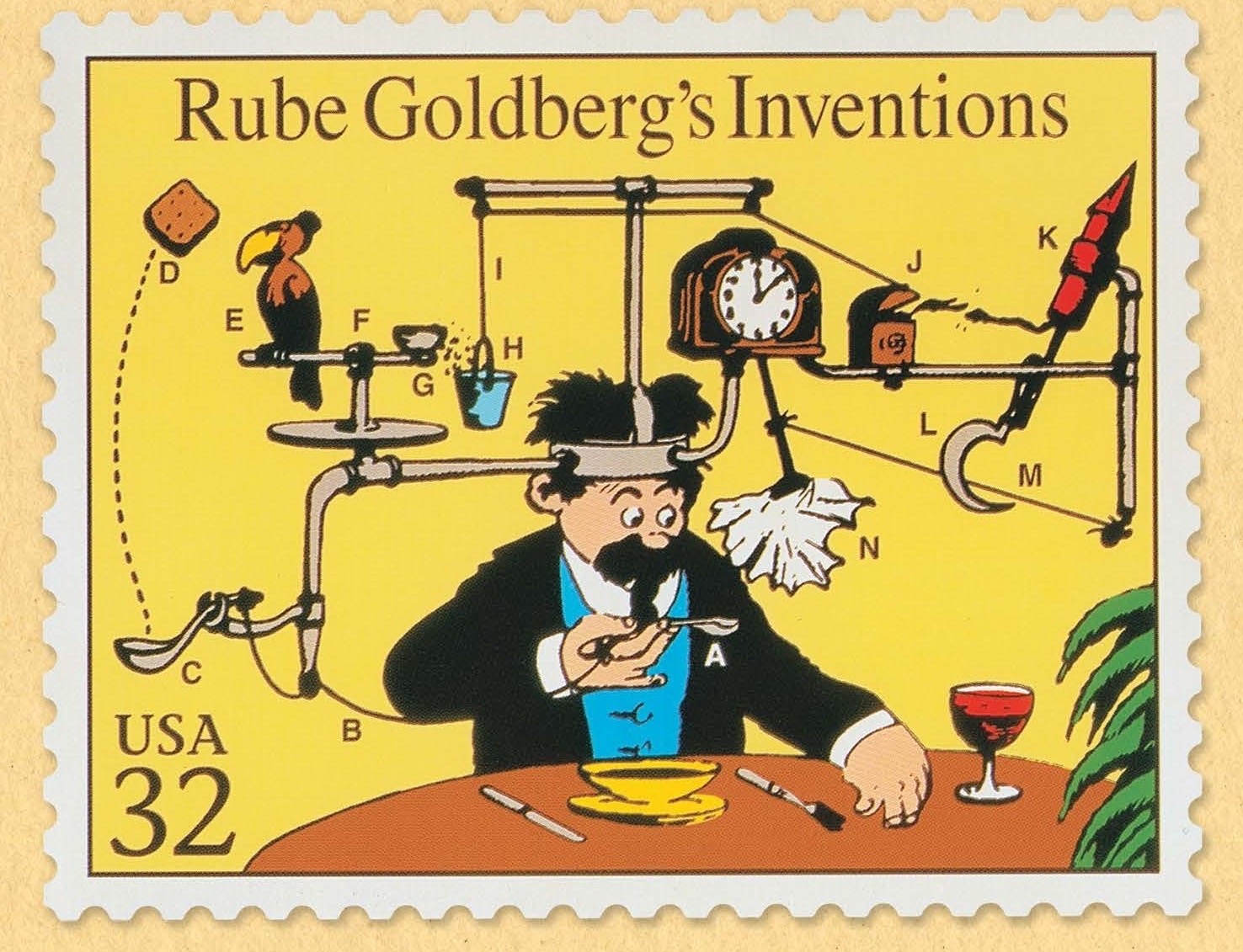
Rube Goldberg Machines Compilation
by Suren Grigorian and Daniel Svediani
The name of Rube Goldberg has become synonymous with the word “mechanism,” with his machines connoting images of complex chain reactions which accomplish a minor and relatively routine task at their end. However, the development of these machines began upon the drawing board, as the original Rube Goldberg developed a reputation for these devices through his artistic precocity.
Rube Goldberg, known originally as Reuben Lucius Goldberg, was born on July 4, 1883, to a San Francisco police and fire commissioner and a member of a Reform Jewish congregation. During his childhood, he displayed remarkable talent in the tracing of illustrations. As he grew up, his inclination toward the arts became apparent, but he was encouraged on a path of engineering by his father, graduating from the University of California, Berkeley in 1904. However, his presence in the engineering community did not last long, as he decided to pursue his original inclination for the arts. He joined the San Francisco Chronicle and the San Francisco Bulletin, gaining cartoon syndication with several newspapers.
By 1915, he became known as America’s most popular cartoonist. His most popular comic strip was The Inventions of Professor Lucifer Gorganzola, which brought him fame and is the one that we all associate with Rube Goldberg. The strip exhibited comically intricate inventions created by a Professor Butts, and these devices would later become known as Rube Goldberg machines. Later, he created a series of seven short animated films depicting the humorous aspects of everyday life.
Check out the awesome student-made Rube Goldberg machine shorts from Mr. Bradfield’s MakerSpace classes in the attached compilation above!
Original Rube Goldberg cartoons:
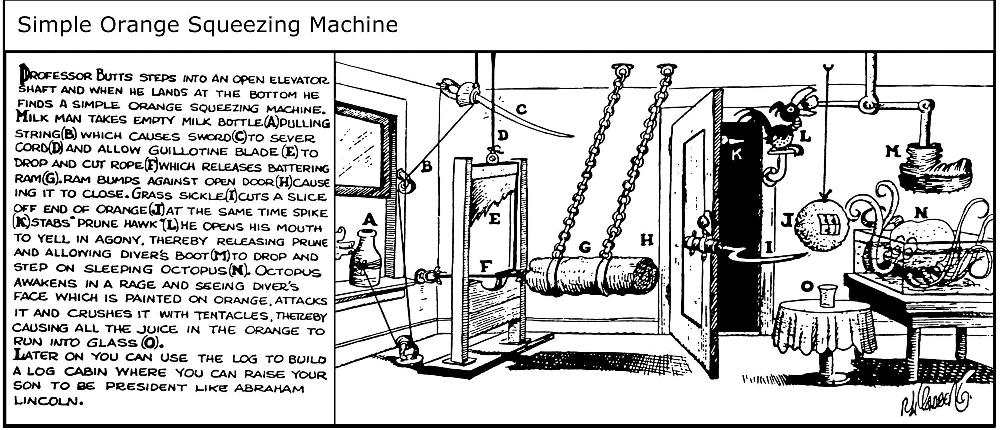


Read More

Zyg Ramsay: 3D Printing Hero
by Ms. Kincaid and David Tang
I’m sure there are many of us who read about what’s happening in the news and see how hard healthcare and frontline workers are working to keep us safe, and we wonder, “What can I do to help?” Well, 8th grader Zyg Ramsay went ahead and decided to do something about it. He saw the challenges that healthcare workers were having getting all the Personal Protective Equipment, or PPE, they needed. With a highly contagious virus like SARS-CoV-2, doctors, nurses and others must have not only masks and full gowns, but also face shields to prevent the microdroplets that could carry the virus from coming in contact with their faces. Zyg saw that Budmen Industries was looking for volunteers to help flatten the curve and protect healthcare workers by using their home 3D printers to print these face shields.
As he explains, “I was fiddling around on the internet and found the Budmen website that contains 3D printing files. You register to become a producer. They didn’t tell me what to do so I just printed one to see how it worked. I thought, “Once they email me to start printing stuff I will.” I got an email from Budmen saying there was an L.A. location, with somebody putting it together in the L.A. area, so I signed up for that. I didn’t have to design the file; you don’t code the printer’s movements, there’s a program that takes a 3D image and converts it into text which the printer follows.”


MS KINCAID: What material do you use to print the face shields?
ZYG: I use PLA [polylactic acid] for the face shields, which is a plastic made from corn, so it is biodegradable. My printer melts it at 200⁰ C and prints each of the 30 layers layer by layer, printing a complete face shield in 2 hours. There are two things I print for it. One is the actual shield in front of the face, and the other is the strap lock that keeps the elastic in place.
MS KINCAID: About much does it cost to make each one?
ZYG: I calculated it at one point, I think it’s around 12¢ of material for each one. I’ve printed 59 shields, so almost 3 kg of plastic.
I asked Zyg how he got into 3D printing. “About 2 years ago, I read about 3D printing in MAKE: magazine. My first printer cost around $200, but it was only able to print up to 4 cubic inches. I got a larger one for Christmas that can print up to 11 cubic inches.”
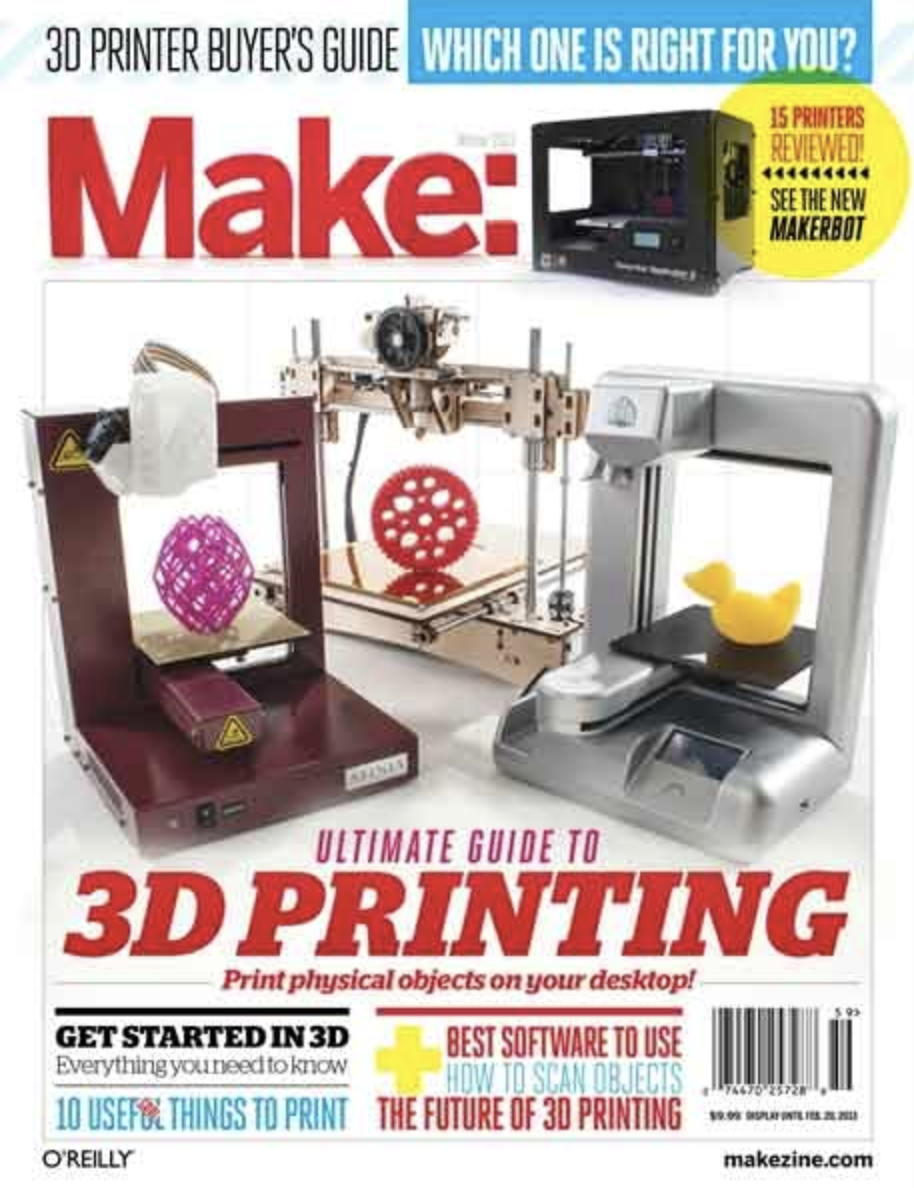
Our interview continued:
MS KINCAID: What else are you working on?
ZYG: Right now I’m working on making two drones. One is a tricopter with three propellers and servo motors to turn the propellers. From what I have read, it’s is much more stable and easier to control, but for some reason it’s less common than the quadcopter, the normal drone with a
MS KINCAID: Why do you think that the tricopter is better than the quadcopter?
ZYG: The tricopter doesn’t turn by slowing down one propeller and speeding another like the quadcopter, it turns the servo. It also doesn’t lean when it moves to the side, it stays in place, which helps people with cameras on their drones.
I’m also working on a minor soldering project. My mom bought a PCB for me, which is a superthin circuit board, and I solder super tiny electronic pieces onto the PCB with solder, which is just super easy-to-melt metal that conducts electricity.
MS KINCAID: Are you just experimenting to see if you can solder that small or are you actually trying to modify the board?
ZYG: I’m just trying to solder that small. Usually I solder bigger things but it has the soldering pads to attach components to it. The last project I’m working on is my MakerSpace project, which is the prosthetic hand controlled by muscle signals.
MS KINCAID: Can you tell us about that?
ZYG: Basically it works with 5 servos connected to string that attaches to each of the 3D printed fingers. When the servo turns one way, the finger closes, and when the servo turns the other way, the finger opens. I control it using muscle signals with a control board connected to a microcontroller like an Arduino. The part connected to the muscle uses EMG [electromyography] to measure difference in electricity between different points on the arm. It uses this EMG to figure out if the person is trying to flex or relax. This works because muscles use actin and myosin fibers, triggered by electrical impulses and powered by ATP.
MS KINCAID: What is your goal?
ZYG: I want to make a very cheap prosthetic hand where you can move each finger independent of each other. Right now your options are: a cheap one that closes all fingers at a time, which is bad for writing or holding circular objects, or an independent-digit expensive hand for around $10,000. Mine would be $150-200 but with independent digits. I would want to program patterns into it for set hand positions because it’s hard to program in each muscle.
MS KINCAID: If this is meant for someone without those muscles? Where would the signals come from?
ZYG: Right now, I control it via my forearm. This is designed for somebody who has no wrist, but still retains most of the forearm, so you can still use the muscles of the forearm. Closing and opening the hand uses muscles in the forearm, not the hand or wrist. Just using the forearm is a bit harder, but you can learn to do it. Studies have shown that with training, you can learn to use your brain to control a whole prosthetic arm.
MS KINCAID: That is cool! Would the stickers with wire be attached to your temples, then?
ZYG: You wouldn’t use the stickers, you would use the headset that goes over your head and measures alpha brain waves. You can’t really control an arm with that outside of the lab because you would have to get something implanted in your brain to control the arm, and you can’t do that outside of the laboratory.
MS KINCAID: So I guess that’s where we are today, and we’ll keep moving forward with the technology. Thanks Zyg, I feel like I learned a lot today!
ZYG: Thanks, you too! Bye!
As Mr. Bradfield, Zyg’s MakerSpace teacher commented, “It was inspiring to see Zyg applying the design and engineering principles he learned in class to a real-world problem.” It is inspiring to see our students take what they learn and help make the world a little bit better!
If you are interested in registering to 3D print face shields, learn more by clicking below:
Read More

3D Printing
How 3D Printers Work
By: Suren Grigorian and Everett Lane
3D printing is a technology which, prior to the beginning of the 21st century, remained exclusively confined to the subjects of industrial manufacturing and prototype production. It is gaining traction in the consumer/recreational world as one of the most ubiquitous and recent technologies of the early millennium; however, a large majority of those who do not have experience with 3D printing remain
The second type of standard commercial 3D printer remains the powder bed fusion type; this type is primarily characterized via a mechanism which, rather than processing and extruding material from a separate store, utilizes concentrated lasers to melt, solidify and fuse a bed of powdered material, normally polyamide plastic, into a final shape. As each fusion cycle is completed, a roller contributes additional material and the cycle begins once more; this type primarily consists of selective laser sintering, patented at the Defense Advanced Research Projects Agency in the 1980s and today the most common type. The objects produced by both types additionally possess varying textures, with the former producing granulated, coarse items and the latter producing smooth, layered and ribbed items; though texture varies, the primary factor which leads the average hobbyist to select one over the other is cost, as powder bed fusion 3D printers are more expensive than the standard fused deposition modeling types.
But what of industrial 3D printers? These 3D printers are primarily characterized via the utilization of technologies which served as the ancestors to the modern 3D printer. Some types of filaments for 3D printing are PLA and ABS, but in this case polymer will be used. These 3D printers usually make their product with a pool of liquid. This is called Stereolithography. First, a roller on the printer spreads out an extremely thin layer of liquid polymer on a platform. Since the layer is a liquid, it will spread out across the entire platform with an even distribution so each layer will have a consistent thickness. The liquid polymer is specially designed to be UV sensitive, so when it is struck with a UV laser it solidifies. Essentially the laser bra is the outlines of the build onto the platform and the places that the laser touch garden. Then the roller rolls a new layer of polymer onto the platform and the platform shifts downwards to facilitate the new layer that has been added to the platform. The process gets repeated over and over again until the build is completed. Then it lifts the newly lasered plastic up out of the resin and the remaining flows away to be used in other builds.
| PLA/Pros | Cons | ABS/Pros | Cons |
| Can be printed on a non-heated surface | Can deform because of heat | Very sturdy and hard | More damaging to the environment. |
| Smells sweet when being printed | Less sturdy than ABS | Suitable for cars and machine parts | Needs to be printed on a heated surface. |
| More environmentally friendly | Higher melting point | Releases plastic fumes when printing. | |
| Higher printing speed | Longer lifespan | More difficult to print. | |
| A lot more detail | Not suitable for using with food. |
So, after looking at this chart you can tell that if you are a recreational printer, you should go with PLA. But, if you are in a more high tech industry, ABS is the way to go. One more thing: The type of printer used has a great effect on the quality of the print. For example, if you have a budget of $200-$300 you would not be able to purchase the highest quality printer. But if your budget is $500-$1000 then you can dive into the field of serious 3D printing. The speed of the printing also affects the quality. If you’re willing to wait, you will get a better finished product of your work.
Medical uses
So, as you might have heard already there have been some breakthroughs achieved in the field of 3D printing organic matter. For example, there have been confirmed reports of 3D printed skin made with an organic printer that has already been used in transplants and large wounds. 3D printing can also be used in transplants because it is so easy to make but it is still being developed.
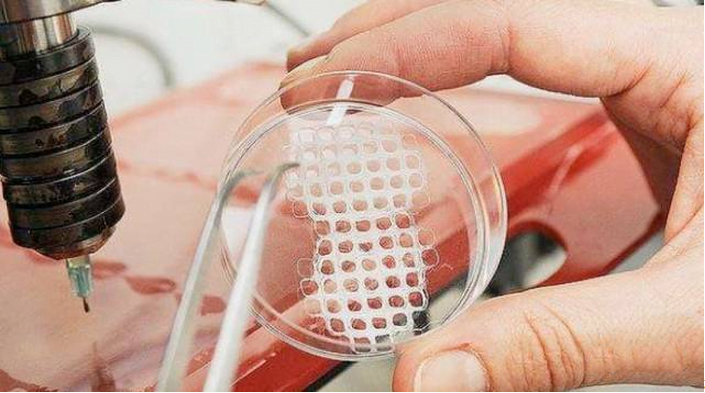
There are also many advantages to having a 3D printed body. Part of that is because it is easier to make than other alternatives. Companies such as Organovo, or Biobots have been doing and researching these alternatives for years. So don’t expect for this to come out for even private use for a while!
3D printing software is important when making something to be 3D printed.. Some people can get the best filament and 3D printer but forget that there is no way to print anything without an engine to print through! Some types of software are Fusion 360 Autodesk, TinkerCAD, and OpenSCAD. (Information from https://all3dp.com/1/best-free-3d-printing-software-3d-printer-program/)
| Name | Function | Difficulty level (To operate) | Platforms |
| TinkerCAD | Design | Beginner | Browser |
| Sculptris | Design | Beginner | Browser |
| Cura | Slicer, 3D printing Host | Beginner | Windows, Mac, Linux |
| Matter Control 2.0 | STL Editor, STL Repair, Cutter, 3D Printing Host | Beginner | Windows, Mac, Ubuntu, Raspberry Pi |
| Astroprint | Slicer, 3D printer host | Beginner | Browser |
| 3D Slash | Design | Beginner | Browser |
| TinkerCAD | Design | Beginner | Browser |
| Vectary | Design | Intermediate | Browser |
| Fusion360 | Design | Intermediate | Mac, Windows |
| FreeCAD | Design | Intermediate | Windows, Mac, Linux |
| OpenSCAD | Design | Intermediate | Windows, Mac, Linux |
| OctoPrint | Cutter, 3D Printer Host | Intermediate | Windows, Mac, Linux, Rasbian |
| Meshmixer | STL Editor, STL Repair | Intermediate | Windows, Mac |
| MakePrintable | STL Editor, STL Repair | Intermediate | Browser |
| Figuro | Design | Intermediate | Browser |
| SketchUp Free | Design | Intermediate | Browser |
| Netfabb | STL Repair, Cutter | Professional | Windows |
| MeshLab | Editor, STL Repair | Professional | Windows, Mac, Linux |
| Blender | Blender | Professional | Windows, Mac, Linux |
Here are some of the many applications of 3D printing:

And now, with the many challenges of having sufficient equipment to handle the caseload of the COVID-19 pandemic, some intrepid printers are modifying existing ventilators with a 3D printed part called a Y-splitter, which can help stretch the capabilities of the world’s limited supply of ventilators by dividing the air flow from a single ventilator to multiple patients. See article below:
https://www.cnn.com/2020/04/18/tech/us-coronavirus-ventilator-3d-printer-intl-hnk/index.html
Read More
BreakThrough Junior Challenge Scholarship
https://breakthroughjuniorchallenge.org/
WELCOME TO THIS YEAR’S
BREAKTHROUGH JUNIOR CHALLENGE
You get it. You’ve grasped an important scientific theory, concept or principle.
Now can you share your insight?
An inventive video can get across complex material that would take pages of text to communicate.
To take part in the Breakthrough Junior Challenge (the “Challenge”), create a short video (3:00 minutes max) to explain a big idea in one of these fields:
- Physics
- Mathematics
- Life Sciences
- COVID-19
Explain a big scientific idea in Physics, Life Sciences or Mathematics with a short video.
You will have until June 25, 2020 at 11:59 PM PDT to submit your video (3:00 minutes max).
You can take part in this year’s Challenge as long as you’re:
- 13 or older by 12:01 AM PDT on April 1, 2020
- Not older than 18 (not yet 19) as of 11:59 PM PDT on October 1, 2020
Your film can take any form you like: animation, talking head, documentary, dramatic reconstruction, whatever. It’s worth keeping in mind that video is a dynamic visual medium – using diagrams, simulations, physical demonstrations etc. is a lot more effective than standing in front of a blackboard talking.
The videos will be judged according to the following criteria:
- Engagement
- Illumination
- Creativity
- Difficulty
For more info, application process, and previous year’s finalists: https://breakthroughjuniorchallenge.org/
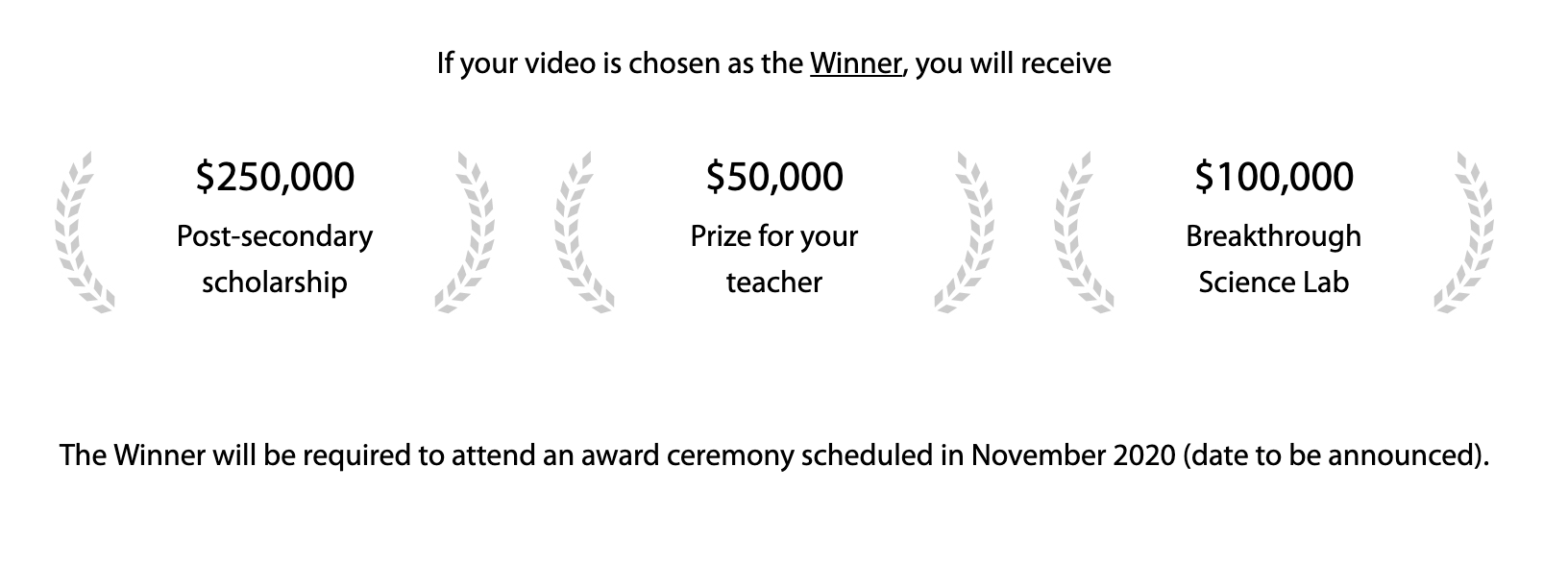

Technology Central: Makerspace

By Jose Salamanca and Gideon Said
This year, the Makerspace lab has been utilized more than ever! Here, kids are allowed to work on any projects they want. In this room, there is a wide selection of materials from flight simulators to VR. You can 3-D print anything you need for whatever project you are pursuing. In this lab at the Science Academy, students are working on very unique and interesting projects. Many of them are direct solutions to modern world problems and other problems of all varieties. One project is a hexapod robot. A hexapod is a six-legged robot. The great thing about it is that you can code whatever movement styles you want! It can walk in a wave or shuffles and many other motions. Also, buying a ready-made hexapod would cost up to $2,000, while building it costs $200!
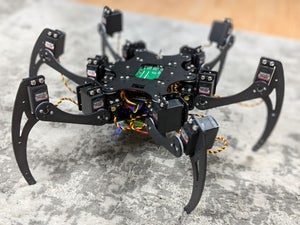
Another project is a VR Driving Simulator which stimulates the effects of drunk driving. It contains features that can change your reaction speed based on your blood toxicity. Also, it blurs the screen to make your vision worse based on the amount of alcohol coursing through you virtually.


Another project is a prosthetic arm that will be controlled with electrical impulses originating from your brain. This will allow the controlling of prosthetic limbs in injured people.

Regenerating concrete is another project trying to be completed. It could prevent against earthquakes and acid rain. The concrete would automatically regenerate itself from any cracks and/or fractures.

Another VR project is a surgery simulator that will be programmed with many different surgeries for medical students to practice on. This will contain many different operations widely used throughout the world on people. You will be able to practice and learn the correct methods when performing surgeries in real-life.
Another group will be designing an entire, interactive VR model of the school. You will be able to explore classrooms and hallways. All of these projects utilize the many capabilities of the Makerspace room. More details of these projects will be provided throughout the year as they develop and are built here in the Makerspace room.
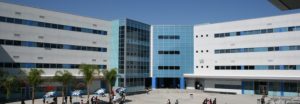
Marshmallow Challenge
Recently in Makerspace, there was a challenge where we had to create the tallest tower we could, using only one meter of string, twenty spaghetti sticks, and one meter of tape. This challenge tests your social capabilities and engineering skills under the pressure of time and limited, low-quality materials. On top of that, it has to hold a marshmallow on top so you have to hope that your marshmallow will not collapse AND be held higher than several other groups. Additionally, the tower has to be free-standing and can not be held for support. A short 18 minutes is all that is provided to the three/four-person group. The marshmallow challenge is mainly based on your skills in working together and breaking things down into simpler parts. This challenge requires clear communication and the ability to quickly start building instead of wasting precious time planning a design. Studies have shown how different types of people have different skill levels in doing this. Surprisingly, kindergartners have one of the highest scores because of how they put the marshmallow up first. Then they slowly add on, but the marshmallow is always on top. Many grades participated in this challenge. Our top record here in the Science Academy was an eighth-grade group at 27 inches tall!

Graph (top) Photo of Marshmallow Towers (bottom)

Read More

